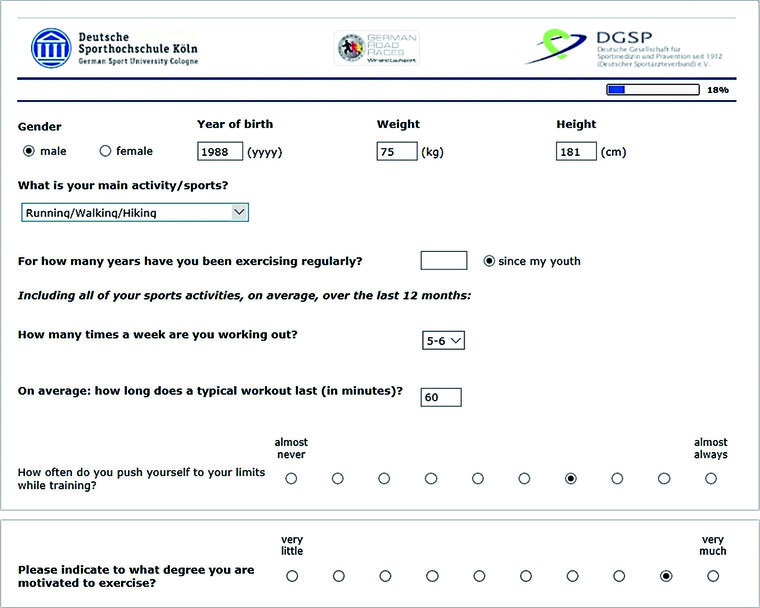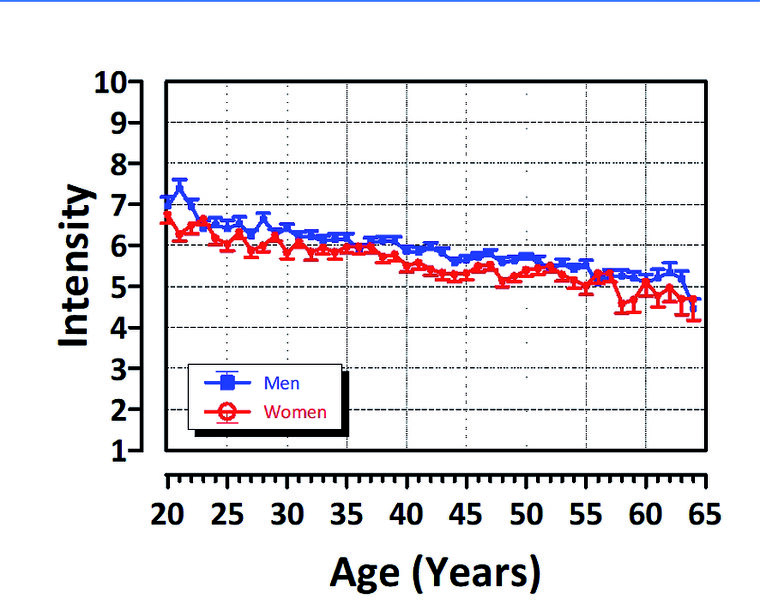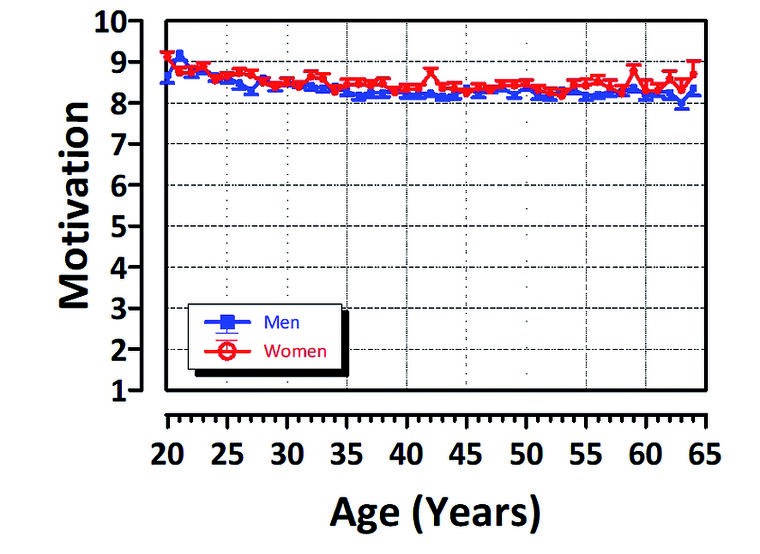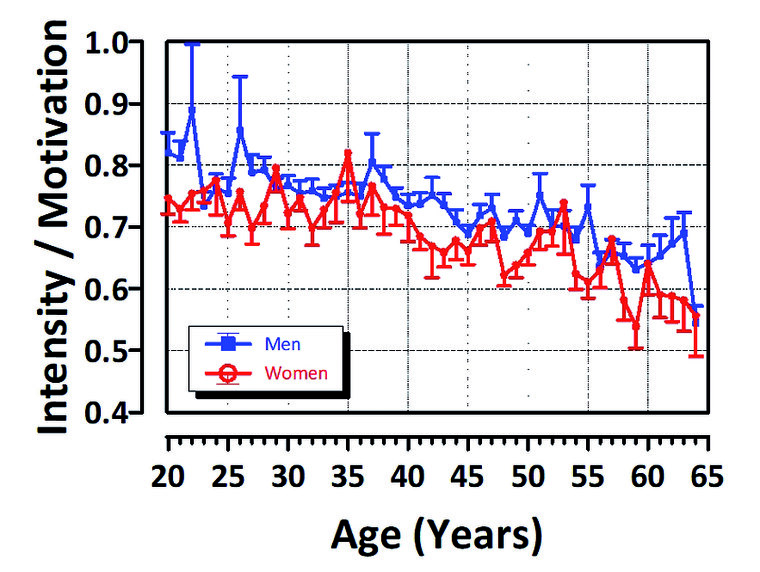Age- and sex-related ability and readiness
for sporting efforts of 20 to 64 years old runners
Thomas Rüther a, Nadine Hartmann b, Alexander Witzki b, Alexander Sievert b, Ralph Schomaker c, Herbert Löllgen d, Dieter Leyk a, b
a German Sport University Cologne, Germany
b Bundeswehr Institute for Preventive Medicine, Andernach/Koblenz, Germany
c Centre of Sports Medicine Münster, Germany
d European Federation of Sports Medicine Associations, Laussane, Swiss
Purpose
Physical and sporting performance are subject to characteristic age-related change processes caused by biological ageing and , not less important, changes in training and lifestyle [1]. Changes restricting physical resp. sporting performance often begin as early as young adulthood [2]. Training parameters like volume and intensity play a decisive role for the adaptive outcome. The present large -scale survey of regularly trained runners examines the ability and willingness to train intensively, and to push themselves to the limits of their capabilities.
Methods
Data from the nationwide survey of actively exercising subjects (www.dshs-koeln.de/med- pace). A subsample of 13,627 runners was extracted from participants with complete datasets (>160,000).
The questionnaire includes items concerning:
- Sociodemographic and anthropometric parameters
- Sporting activity (e.g. training habits, sport experience)
- Health and medical risk factors (modified PAR-Q)
- Subjective data about how often subjects train close to the limits of their physical capacity (“exercise intensity“)
- Degree of motivation to exercise
Sample selection criteria:
- Regular training for at least 2 years
- 2-5 sessions/week and running volume 11-60 km/week
Statistics:
- ANOVA, correlation, and regression analyses

Fig. 1: Screenshot of the online questionnaire
Results
Sample characteristics
- 13,627 subjects total: 8,592 men/5,035 women; (age: 43.7±10.5/40.3±10.9 yrs; p<0.001)
Running experience and training volume
- Experience: 10.4±9.1 vs. 8.6±7.5 yrs (men vs. women); p<0.001)
- Volume: 32.2±12.3 vs. 28.5±11.5 km (men vs. women; p<0.001)
Exercise intensity & motivation
- Exercise intensity (figure 2) and relation intensity/motivation decrease with age (figure 4).
- Motivation remained almost constant (figure 3).
- Women rarely train to performance limits, reported greater motivation and lower intensity/ motivation (5.66±1.88 vs. 5.80±1.89, 8.45±1.44 vs. 8.31±1.37, 0.70±0.39 vs. 0.72±0.36, each p<0.001).
- Intensity is correlated with age, motivation, and running experience (r=-0.21,r=0.14, r=-0.12, all p<0.001).
- Age, motivation, and sex are strongest predictors for intensity (standard-beta -0.18, 0.14, -0.06, all p<0.001).
- Training volume and health status had no explanatory value.

Fig. 2: Exercise-intensity of runners stratified by sex and age
(mean±SE):
- sex F(1, 13,537)=14.4, p<0.001
- age F(44, 13,537)=55.6, p<0.001
- sex x age F(44, 13,537)=0.9, p=0.603
Fig. 3: Motivation for exercise of runners stratified by sex and age (mean±SE):
- sex F(1, 13,537)=3.0, p<0.001
- age F(44, 13,537)=14.1, p<0.001
- sex x age F(44, 13,537)=0.9, p=0.606
Fig. 4: Relation Intensity/Motivation of runners stratified by sex and age (mean±SE):
- sex F(1, 13,537)=4.7, p<0.001
- age F(44, 13,537)=26.9, p<0.001
- sex x age F(44, 13,537)=0.8, p=0.804
Conclusion and relevance
The frequency of training close to the individual physical limit is declining with age in running men and women. Despite consistently high motivation for exercise in all age groups, self reported exercise intensity is also decreasing with age . Both extensive endurance training and high intensity training loads are relevant aspects for the maintenance and improvement of overall physical fitness. To maintain the ability and readiness for intensive training efforts, the application of more varied and high intensity focused training like CrossFit or high-intensity interval training (HIIT) might be advisable even in advanced age groups.
References
- Leyk D, Ruether T, Wunderlich M et al.: Physical Performance in Middle Age and Old Age. DtschAztebl Int 2010; 107(46): 809-816. mehr lesen
- Leyk D, Ruether T, Witzki A et al.: Physical Fitness, Weight, Smoking, and Exercise Patterns in Young Adults. Dtsch Arztebl Int 2012; 109(44): 737-745. mehr lesen
For the authors
Dr. Thomas Ruether
German Sport University Cologne
Institute of Exercise Training and Sport Informatic
Department IV: Exercise Physiology
Am Sportpark Muengersdorf 6, D-50933 Cologne
E-Mail: ruether@dshs-koeln.de
Posterpresentation at the ICSSP 2020 in Quebec, Canada (11 to 14 February 2020)